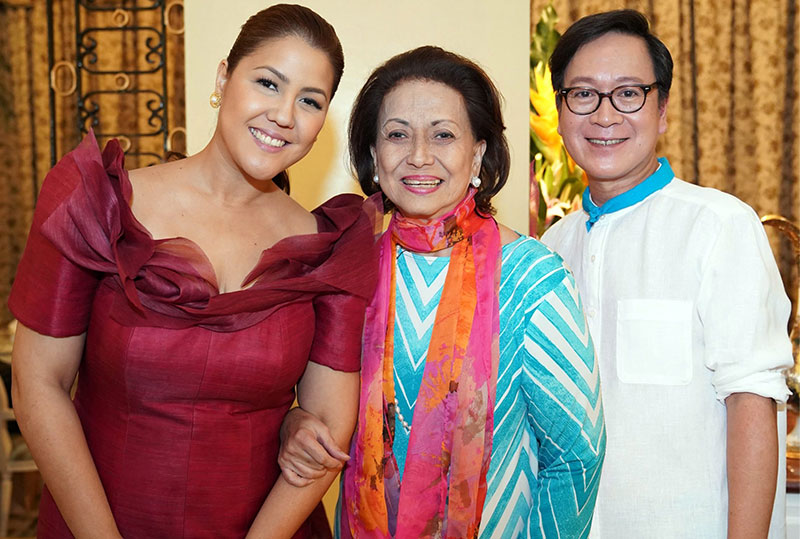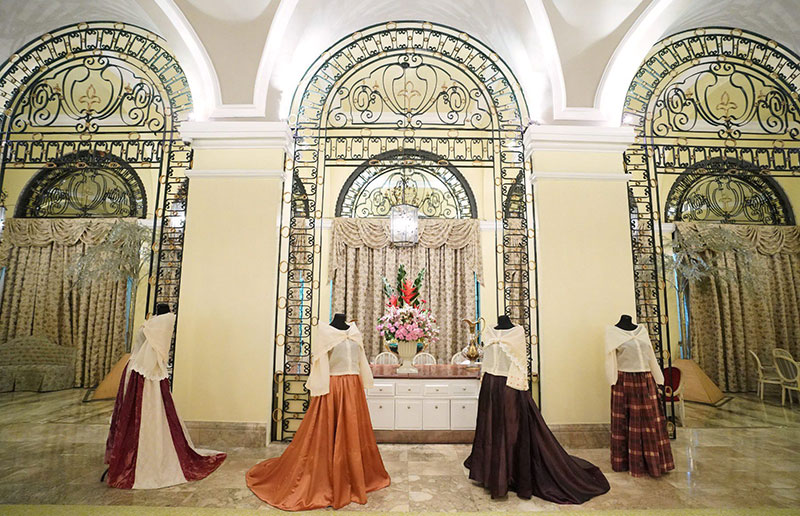It's ‘Balik Saya’ – both the joy and the Philippine dress – with Cristal Bagatsing

Manila Fifth District Representative Cristal Bagatsing is a vision of timeless elegance and contemporary polish in a Jojie Lloren modern terno-meets-baro’t saya. The pañuelo, typically worn on the front, drapes on the back as a detail flattering the first-termer from every angle.
Turning heads in The Champagne Room under its sparkling crystal palm trees, thanks to the way the terno makes one stand tall, you couldn’t tell she was nervous, discreetly taking a whiff of her blend of relaxing essential oils in between — an “oil-bularyo,” she is.
Dressed for the occasion launching Balik Saya, her Manila Heritage Month project with the Department of Tourism and Intramuros Administration, translates to two things in the vernacular: bringing back joy in the historical district, as well as referring to the skirt in baro’t saya, Maria Clara’s Filipiniana of choice and the piece that the fashion design competition honoring the Noli Me Tangere protagonist’s values will update and make new.??
“Ang daming nagrereklamo sa Facebook na lagi sila nababastos sa jeep o sa bus,” Cristal says, recalling the candid coversation with Intramuros Administrator Atty. Guiller Asido that started it all. “I said, ‘It would be nice to remind the youth about conservatism, the essence of a Filipino woman, which is Maria Clara.’ Na pwede naman maging conservative kahit liberated. And then it evolved.” ??

Modern Maria Claras: Manila Fifth District Representative Cristal Bagatsing and mom Chari Bagatsing with designer Jojie Lloren
While the reality of Manila public transportation has Filipinas channeling the boldness of the Amazon-like mythical warrior Princess Urduja from Pangasinan, or real-life revolutionary leader Gabriela Silang from Ilocos Sur, perverts aside thanks to the usual crush of rush hour, Cristal offers a mix of the two with the demure and self-effacing Maria Clara.
“Alam niya kailan siya makikibaka at kailan siya tatahimik. She knows when to choose her battles.” ??
She refers to her mother Chari as the epitome of Maria Clara, whose everyday wear is either Criselda Lontok or Natori. “She is elegant, mahinhin, and proper,” she says and admits, “I hope to be able to emulate her.”
Chari says Cristal takes after her father, former Manila Congressman Amado Bagatsing, known for his larger-than-life personality. Cristal’s battle is in reviving the district she grew up in. “We used to have a lot of designers from the district. Sa labas pa lang ng bahay namin we have Ben Farrales, Auggie Cordero, Pitoy Moreno and Inno Sotto. Puro walking distance. My mom would always go and I would tag along,” she recalls.
Originally slated for Women’s Month, it made more sense to hold it during Heritage Month. “It was the hub of creative minds and we hope to bring that back. The Fifth District is the tourism belt of the Philippines. Beyond history, beyond The Walled City, there’s also a lot of poverty goes on,” she adds. “We want to remind people that those who will come and support the project that we have to connect the gap. We hope this will generate more jobs and livelihood through making tourism more local. Pag nakakuha sila ng trabaho dito, mas aalagan nila.”??
Modernizing the baro’t saya
Maria Clara is the baro’t saya’s most popular wearer, her favored iteration characterized by designer Jojie Lloren: “The pañuelo is the defining part of it. The top always ends on the waistline. From what I learned from (scenographer and Fashionable Filipinas: An Evolution of the Philippine National Dress in Photographs 1860-1960 co-author) Gino Gonzales during his seminar talk on the history of the baro’t saya with the designers, Maria Clara’s baro’t saya is traje de mestiza with the pañuelo, bell sleeves and a long skirt.” ??
Compared to other Filipiniana such as the butterfly-sleeved terno, the vibrantly printed tapis, or the shorter, summertime choice, balintawak, the baro’t saya comes in separates — there are more elements to play with.??
“They can modernize the Maria Clara any way they like as long as it still instills the values of the original. No high slits, no plunging necklines,” Jojie says. “It has to have the semblance of baro’t saya.”??
Jojie is Manila high society’s go-to for his minimal, Parisian aesthetic, informed by his French couture education. More recently he has mainstream culture recall as the Tim Gunn of the Philippines as mentor on Project Runway Philippines. He may be a Pasay resident, but Cristal knew he was perfect for the role and she is right. The country’s esteemed designers like Jojie have been up to the task of modernizing and making Filipiniana relevant again, but Balik Saya opens the catwalk to untapped perspectives, qualifying only amateurs with little to no experience, from seamstresses, non-fashion college students, to out-of-school youth who either reside or study in Manila’s 5th District. Forty contestants joined with a sketch and were narrowed down to 18, who are now working on their one make-or-break baro’t saya over the course of a four-week mentorship program using seed money. The finished piece should be made of at least 25 percent indigenous fabrics like piña, jusi and inabel. ??

Fashion mirrors heritage: Archival pieces of baro’t saya from the Cultural Center of the Philippines. A Patis Tesoro exhibition on the history of the iconic ensemble is on view at the Destileria Limtuaco Museum May 17-26.
Cristal wears another Jojie Lloren baro’t saya as a pantsuit in the promotional materials, a navy piña number that epitomizes the kind of pieces we hope to see on the culminating fashion show on May 28. to be directed by Jackie Aquino. You know the contestants are getting the celebrity treatment as their creations will be one of the first events to be staged in a venue as grand as the National Museum of Natural History. (The first and latest one was designer John Herrera’s Agila ball last month.)
On the days leading up to the event, a Patis Tesoro exhibition on the history of the iconic ensemble will be on view at the Destileria Limtuaco Museum in Intramuros from May 17 to 26.??During the show on the 28th, pieces will be judged based on design, workmanship, wearability and originality by the who’s who in Philippine fashion: Inno Sotto, Tweetie De Leon-Gonzalez, Criselda Lontok, Randy Ortiz, a representative from SoFA Design Institute, as well as Jojie himself, National Museum director Jeremy Barnes and DOT Secretary Wanda Tulfo-Teo.
Five designers will win cash prizes (up to P100,000 for the first prize), an apprenticeship in Rustan’s under Portuguese ready-to-wear designer and creative director Ricardo Preto, an overnight stay at The Bayleaf in Intramuros, and a workshop from SoFA Design Institute. Special awards “Most Promising Ready-To-Wear Design” and “Jojie’s Choice” will be given, which could be a contestant who isn’t in the top five.??



















